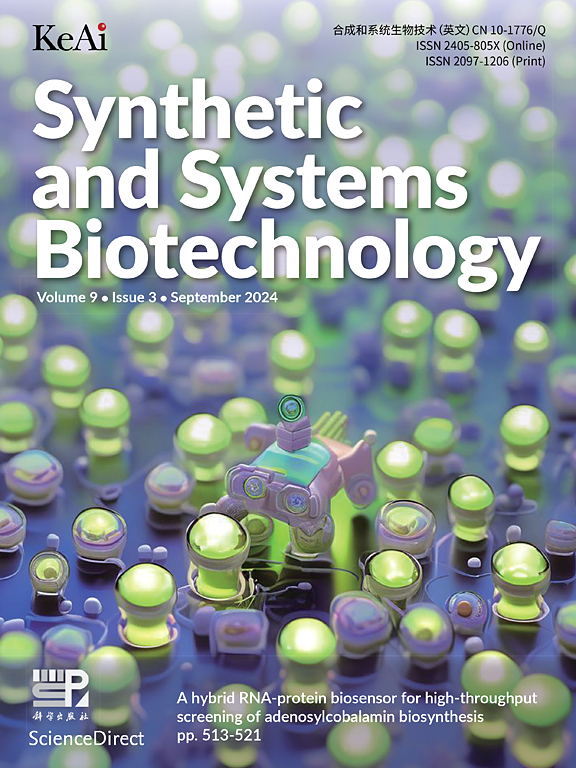Morphology-engineered alleviation of mycelial aggregation in Streptomyces chassis for potentiated production of secondary metabolites
IF 4.4
2区 生物学
Q1 BIOTECHNOLOGY & APPLIED MICROBIOLOGY
引用次数: 0
Abstract
The genus Streptomyces exhibits a complex life cycle of morphological differentiation and an extraordinary capacity to produce numerous bioactive secondary metabolites. In submerged cultures, Streptomyces species usually grow in the form of mycelial networks and aggregate into large pellets or clumps, which is generally unfavorable for industrial production. This study aimed to construct efficient microbial cell factories by manipulating morphology-related genes. We herein employed a morphology engineering approach to generate eight engineered derivatives (MECS01∼MECS08) of Streptomyces coelicolor M1146, a versatile chassis widely used for the heterologous production of various secondary metabolites. We found that genetic manipulation of morphology-related genes exerted a substantial influence on the growth and mycelial characteristics of the engineered strains. Once the native actinorhodin gene cluster was introduced into these strains, antibiotic production increased in all engineered strains compared to the parental strain. Notably, a significant elevation of actinorhodin production was observed in three of the engineered strains, MECS01, MECS03 and MECS05. Similar scenarios occurred when expressing the staurosporine gene cluster and the carotenoid gene cluster in these three engineered derivatives, respectively. Our study demonstrates that morphology engineering represents an effective strategy for alleviating mycelial aggregation. It has also expanded the toolkit of Streptomyces chassis available for the heterologous expression of gene clusters encoding a variety of secondary metabolites.
形态工程减轻链霉菌的菌丝聚集,以增强次生代谢物的产生
链霉菌属表现出复杂的形态分化生命周期和产生大量生物活性次生代谢产物的非凡能力。在水下培养中,链霉菌通常以菌丝网络的形式生长,并聚集成大的球团或团块,这通常不利于工业生产。本研究旨在通过操纵形态相关基因来构建高效的微生物细胞工厂。本文采用形态学工程方法生成了8个链霉菌(MECS01 ~ MECS08)的coelicolor M1146的工程衍生物(MECS01 ~ MECS08),这是一种广泛用于各种次生代谢物的异源生产的通用底盘。我们发现,形态相关基因的遗传操作对工程菌株的生长和菌丝特性有实质性的影响。一旦将天然放线菌素基因簇引入这些菌株中,所有工程菌株的抗生素产量都比亲本菌株增加。值得注意的是,三个工程菌株MECS01、MECS03和MECS05的放线菌素产量显著升高。在这三种工程衍生物中分别表达staurosporine基因簇和类胡萝卜素基因簇时,也出现了类似的情况。我们的研究表明,形态工程是缓解菌丝聚集的有效策略。它还扩展了链霉菌的工具箱,可用于编码各种次生代谢物的基因簇的异源表达。
本文章由计算机程序翻译,如有差异,请以英文原文为准。
求助全文
约1分钟内获得全文
求助全文
来源期刊

Synthetic and Systems Biotechnology
BIOTECHNOLOGY & APPLIED MICROBIOLOGY-
CiteScore
6.90
自引率
12.50%
发文量
90
审稿时长
67 days
期刊介绍:
Synthetic and Systems Biotechnology aims to promote the communication of original research in synthetic and systems biology, with strong emphasis on applications towards biotechnology. This journal is a quarterly peer-reviewed journal led by Editor-in-Chief Lixin Zhang. The journal publishes high-quality research; focusing on integrative approaches to enable the understanding and design of biological systems, and research to develop the application of systems and synthetic biology to natural systems. This journal will publish Articles, Short notes, Methods, Mini Reviews, Commentary and Conference reviews.
 求助内容:
求助内容: 应助结果提醒方式:
应助结果提醒方式:


